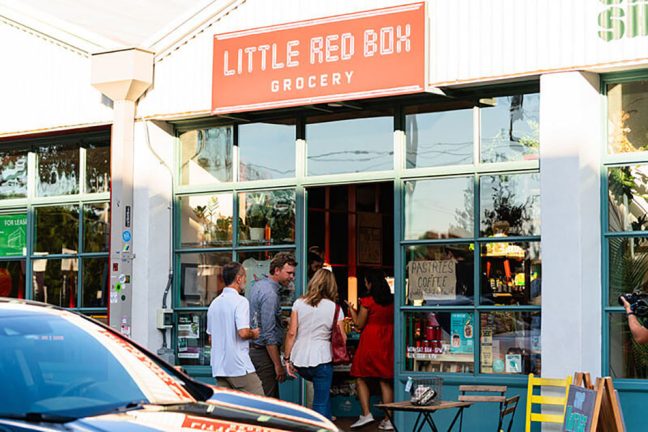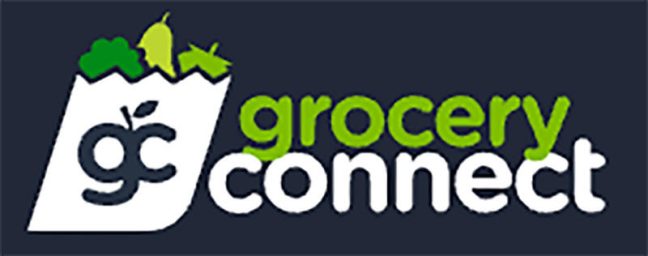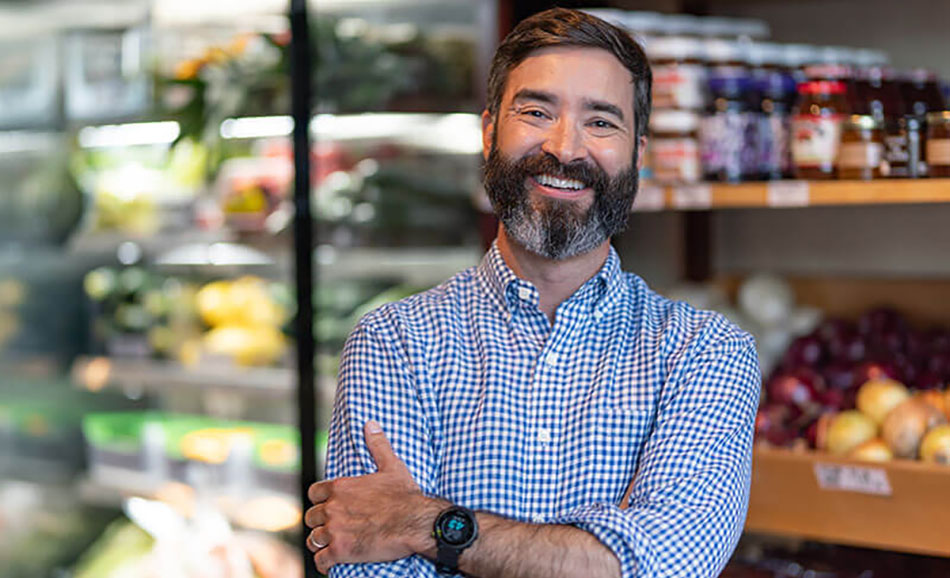Sam Newman was fresh out of a meeting with the Houston Downtown Management District when The Shelby Report of the Southwest caught up with him April 1.
That meeting involved his mission to connect people and fresh food in areas where those connections currently aren’t being made.
Newman’s mission started to take form after he graduated from the University of Texas-Austin and went to work in Washington, D.C., in international trade development for the U.S. Commerce Department and then for the World Bank. His work with both organizations had a component of poverty alleviation.
“Maybe that planted a seed in my brain or something,” said Newman, who went on to earn an MBA at Georgetown before joining H-E-B in San Antonio.
There, he was put on a project that involved figuring out how the grocer could best serve SNAP and WIC households in Texas, ensuring they were afforded “choice and dignity and value,” Newman said.
He moved to Houston eight years later when he was tapped to lead a nonprofit, Brighter Bites.
“The way I describe Brighter Bites is it’s a public health nonprofit that masquerades as food distribution,” he said.
Working in partnership with organizations like food banks and local produce distributors, Brighter Bites goes into lower-income schools, predominantly elementary schools, and provides about 25 pounds of fresh produce to students – and, by extension, their families – for 16 weeks during the course of the school year.
Newman explained, “The idea is that through this regular intervention of healthy food access, complementing that with nutrition ed, can you start to, as they would say, reduce intimidation by produce? Could you start to shift the social norm and expectation in a way that changes health outcomes for a child, their family and a community?”
The education component came through a partnership with the UT School of Public Health.
“They have proven that it’s working, so it is really exciting,” Newman said. “But my big learning there, on top of my access learning at H-E-B, was demand for good food exists irrespective of zip code.”
So his next step was to directly serve one of those zip codes. His enterprise, Little Red Box Grocery, started out in early 2020 in Galveston. Acknowledging “the good Lord’s timing,” it started out as a click-and-collect/curbside pickup venture that was perfect for the early days of the COVID-19 pandemic.
Little store that almost made it
In 2022, Little Red Box Grocery was relocated to Houston’s Second Ward, a food desert area. It was a brick-and-mortar location at 3401 Harrisburg Blvd. The store had about 700 square feet of selling space and about 800 SKUs. It sold fresh produce as well as some everyday essentials.
The produce selection ranged from avocados from Mexico to lettuce grown down the road, according to Newman.

Photo: Yellowbox
The store offered Double Up Food Bucks, allowing SNAP shoppers to get twice the amount of produce for the same dollars, and it held events to enroll eligible residents in SNAP and WIC, which the store accepted as payment.
“We implemented programming that tried to reduce barriers [to food access] as best we could,” Newman said.
In addition to supporting local produce growers whose harvests were not large enough to meet the needs of larger grocers – which led to really fresh produce, “thrilled” customers and very little shrink – Little Red Box Grocery also sold products from local small-scale ranchers and other food producers, such as fresh bread and tortilla makers.
“The best tortilla chips you’ve ever had in your entire life,” he said of the local brand Little Red Box carried. “I mean, this is a $9 bag of tortilla chips, and I could not keep them on the shelf.”
By late 2023, it became apparent the store could not sustain itself. The store was $33 an hour away from profitability.
“By the end of it, we all joked – my small team and I – that it’s not working, but it’s working,” Newman said. “It was working in so many different ways. You could really feel the energy in that store when people were in there.
“And what I thought was the most beautiful thing in the world, and it happened every day, was someone of a greater financial means was checking out shoulder to shoulder with someone with significantly less, and each of them enjoyed an equitable experience. Maybe paying different but engaged in the same act and in the same small space. You do that enough times, and you really can feel hope for what can be, right?
“It didn’t work, which was a real bummer,” Newman said.
He recounts a few factors that caused the store to fall short of its needed revenue.
As a small store, Little Red Box didn’t hold much buying power. He said he was buying cases of bananas for $30 but could walk into a retail store in Houston that was selling cases for $18.
“I will admit that’s an extraordinary example, but it’s also directly appropriate in terms of the challenges we were up against,” he said.
With the store size, there were always decisions to be made on what to carry. For example, there were not multiple sizes of soft drinks or other items offered.
“We were making some decisions on behalf of our customers, just like decisions are made upstream from all of us every day, in every category,” he said. “We were making some decisions that we thought were the right way of doing business that probably turned a few people off.
“But, quite frankly, because of the assortment and our store size, our basket size was too small. Our basket size was $10; we had pro-formatted it at $25. Our customer count was extraordinary, but it wasn’t 2.5-X extraordinary.
“At the same time, a number of our customers were very loyal,” he added.
Though the store did offer convenience, particularly for those traveling on foot, Little Red Box Grocery was located on a one-way street, on the left side, close enough to a traffic light that people often gunned it to make it before the light turned red. That means they didn’t necessarily notice the store if they weren’t looking for it.
“It’s hard to see neighborhood retail at 40 miles an hour,” he pointed out.
Regardless of the outcome, Newman said he had a wonderful staff.
“My labor was amazing; we never had a staff problem,” he said. “We never had a shrink problem, certainly not with theft. And we really tried to mitigate stuff going bad on shelf. I think we can ‘blame’ a lot of things for our lack of customer count, but it is what it is. And the good Lord taught me a few lessons about the process. I’m still motivated by the idea of solving this problem as best we can.”
New way to tackle food access
After a few months of licking his wounds, Newman was ready to re-engage with efforts to get food access to those who need it.
He now leads Grocery Connect, an effort that grew out of Bonton Farms. Located in the South Dallas community of Bonton, which has a population of about 5,000, the organization was created by Daron Babcock, who had moved to the area and realized that getting fresh food required a three-hour roundtrip to Dallas.
According to the Bonton Farms website, the rates of disease in Bonton far outpace those of Dallas – cardiovascular (54 percent higher), diabetes (45 percent), stroke (61 percent) and cancer (58 percent).
Babcock planted a garden on the abandoned lot beside his home in Bonton in what he called “an act of defiance” against the food desert conditions in the area. Law enforcement wrote him a ticket for his efforts. So he decided to start a nonprofit called Bonton Farms as a reminder of how it all started.
In addition to the two acres where crops are cultivated in Bonton, the organization now operates a 40-acre farm, health and wellness center that offers medical and dental services, farmer’s market, restaurant, coffee shop, financial services and teaching kitchen.
 But a full-service grocery store coming to the area has remained out of reach. A few years ago, Babcock and other leaders in Bonton came to terms with the fact that it likely will never happen, so they got creative. The solution is Grocery Connect, which brings mainstream supermarket offerings into the communities where it’s needed via e-commerce.
But a full-service grocery store coming to the area has remained out of reach. A few years ago, Babcock and other leaders in Bonton came to terms with the fact that it likely will never happen, so they got creative. The solution is Grocery Connect, which brings mainstream supermarket offerings into the communities where it’s needed via e-commerce.
They approached Kroger, which has long offered a range of e-commerce options for its customers. Kroger operates an order fulfillment hub in South Dallas through its partnership with Ocado, so was there a way for residents to order their groceries online, collectively, and have them all delivered to a central location for pickup on a designated day? Yes.
Today there are two Grocery Connect sites up and running in the Dallas area. The centers were created via a partnership among Bonton Farms, Kroger and Share Our Strength.
One opened in January 2024; it’s at the Innercity Community Development Corp. and serves the Frazier and Mill City neighborhoods. The other opened in July 2024 at the Dallas Bethlehem Center, which serves South Dallas and Fair Park residents.
Grocery Connect employs concierges who walk residents through how to place orders online and pay for groceries. Shoppers can pay by debit, credit, SNAP or WIC. With Grocery Connect’s partnerships, the shopper is given a code that waives fees.
“So if you want $35 in groceries, you pay $35; there’s no surcharge or delivery fee or tip that typically gets a $35 basket up to around $50, which is not covered by SNAP,” said Newman, who also consults on food initiatives for Concentric Community Advisors.
Concierges perform a range of other services, like showing people how to find healthy recipes. Cooking and nutrition classes and meal planning assistance also are planned for Grocery Connect locations.
“We go into an existing community-based organization that has traffic and traction and trust and physically position someone at that organization,” Newman said. “Our employee – the concierge – helps enroll people in benefits, helps with the partnership with a great organization called Connected Dallas. We help bridge the digital divide, getting people online, comfortable with e-comm.”
Once all the orders are placed for the delivery cycle, residents are assigned a time slot for pickup on the designated day when the Kroger van will make its deliveries.
The Kroger driver, in a box truck with refrigerated compartment, stays for the three- to four-hour window of scheduled grocery pickups. The driver brings only what was ordered, so there is basically no shrink involved.
“The economics do not allow for Kroger to get orders to individuals’ front doors; what it does allow is delivery at the community-based organization,” Newman explained.
Delivery day brings people together, like a grocery store visit might do. They can sit down and have a cup of coffee together while they wait for the truck.
“I think there’s a way to put people that have been left behind, when talking about grocery access, at the front of the line,” he said.
The hope is that as Grocery Connect gains traction in Dallas, it will be able to “grow to other cities in other states,” including Houston. “But we’ve got to prove … that it can work in Dallas.”
While having a brick-and-mortar grocery store in an area is great, “let’s not make the store getting built the end game,” Newman said. “Let’s make getting good food on people’s table the end game.”
[RELATED: Led by Lone Star State, Southwestern U.S. Ripe For Grocers]

